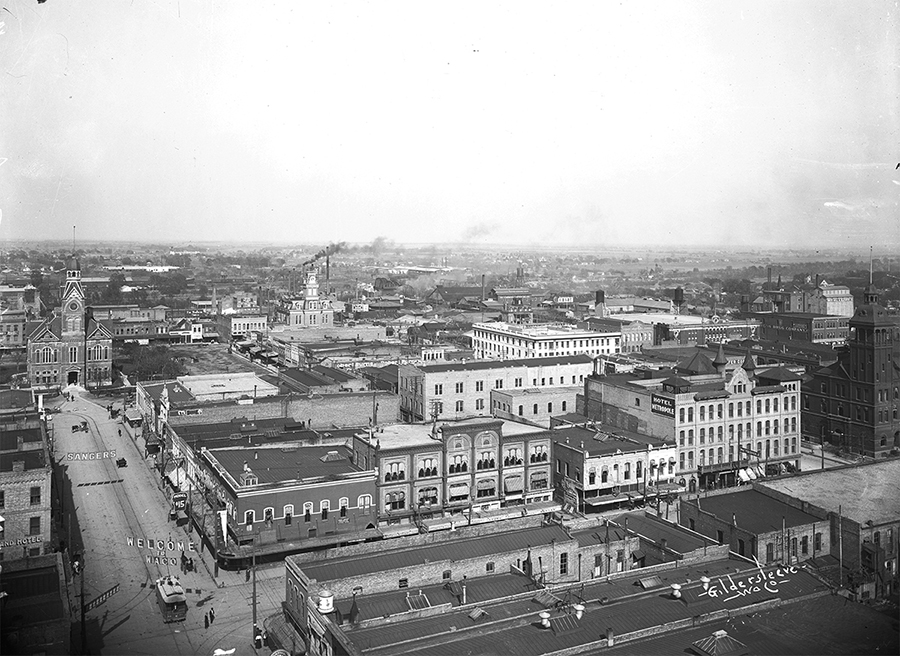By Geoff Hunt, Audio and Visual Curator

Built in 1912, the Huaco Club was one of the places to be for Wacoans of the 1910s. From golf and tennis to social events, wealthier Wacoans enjoyed spending time at the country club, located near Sanger Avenue and 29th Street.
However, the club didn’t last long. On January 4, 1917, the Huaco Club lost its clubhouse and surrounding structures to a devastating fire. A three-story building designed by architect Roy Lane, the clubhouse included two dining rooms, a parlor, offices, living rooms, reading room, and ballroom. The club also featured a nine-hole golf course, bowling alley, and tennis courts, on 50 acres. The next morning’s Waco Morning News reported: “Not a stick of the building or its contents was saved.”

The club’s president, Dr. J.W. Hale, estimated that the fire’s destruction of the facility amounted to $70,000. In 1917, that was a hefty sum—in today’s money, that would equal nearly $2.3 million! Apart from the clubhouse, estimated at $35,000, and furnishings, the club’s stock of golf equipment for sale, and members’ personal gear were lost as well.
A report published soon after the fire in Safety Engineering, “Recent Fires and Their Lessons,” stated “Cause unknown” for the Huaco Club fire. But fire investigators concluded that losses were aided in part by the club’s late fire alarm system causing a delayed response by firefighters. It was also believed that its construction of easily combustible material enabled structures to become quickly engulfed by the flames.
The Huaco Club was the first golfing facility of its kind in Waco. In a 1915 article in The Waco Morning News, James Hays Quarles attributes Walter V. Fort with bringing golf to Waco in 1896. Fort was inspired by golf courses he saw in Dallas and worked with other prominent local citizens to assemble assets needed to establish a golf club.

The charter for the Huaco Club was organized and signed on May 20, 1910. It called for $40,000 to be raised with 200 members purchasing shares of $200 apiece. The charter stated: “The purpose for which this corporation is formed is to support and maintain a country club for the promotion and encouragement of outdoor life, the games of golf and tennis and other innocent sports and amusements.” In 1913, the shareholder number met its goal. By October 1915, it had 183 stockholders with 63 associate members.
The club was more than just about sports—it was a meeting place for many Wacoans and out of town visitors. Many well-known Waco businessmen and prominent male and female citizens were on its membership rolls. The club frequently hosted luncheons, dinner parties, dances, weddings, and banquets, mentioned in the society columns of Waco newspapers on many occasions.

Even though the Huaco Club and its contents were insured for approximately $26,000—far less than the $70,000 loss caused by the fire—plans for another golf facility were soon made. Chartered on August 27, 1917, and built circa 1920, the remaining club members opened a new facility, Spring Lake Country Club, at Day’s Lake in what is now Lacy-Lakeview. It included a larger course with 18 holes and an elaborate clubhouse. In a similar fashion as its predecessor, the new club continued to carry on various recreational as well as social functions. Meanwhile, the land the club occupied around 29th and Sanger Avenue was developed into one of Waco’s early “suburbs.”
The early days of golfing in the Waco area did have its setbacks and losses. But the sport that was once referred to as “pasture pool,” played in areas shared with grazing cattle, overcame such setbacks as the Huaco Club fire. Indeed, the love of the game, as well as the way it brings people together, still makes golf and its related activities thrive to this day, in and around Waco.
See more photos of the Huaco Club—before and after—in the Flickr slideshow below.
Created with flickr slideshow.
Sources
“Committee to Consider Probable Site for New Huaco Club House is Named; To Report Tuesday Night,“ Waco Morning News (Waco, TX). Feb. 2, 1917.
“Cows and Golfers Took Sporting Chance With Each Other When First Course Was Opened in Waco,” The Waco News Tribune (Waco, TX.). Apr, 5, 1925.
“Huaco Club is Completely Destroyed by Fire” Waco Morning News (Waco, TX), Jan. 4, 1917.
McReynolds, Mrs. B.B. “Current Events in Woman’s Sphere: Friday Night at the Huaco Club,” Waco Morning News (Waco, TX), Aug. 29, 1915.
Quarles, James Hays. “Waco Golf Club and Some of its Interesting History,” Waco Morning News (Waco, TX), Oct. 31, 1915.
“Recent Fires and Their Lessons: Clubhouses, City and Country,” Safety Engineering, v.33 (Jan.-June, 1917): p. 243.




